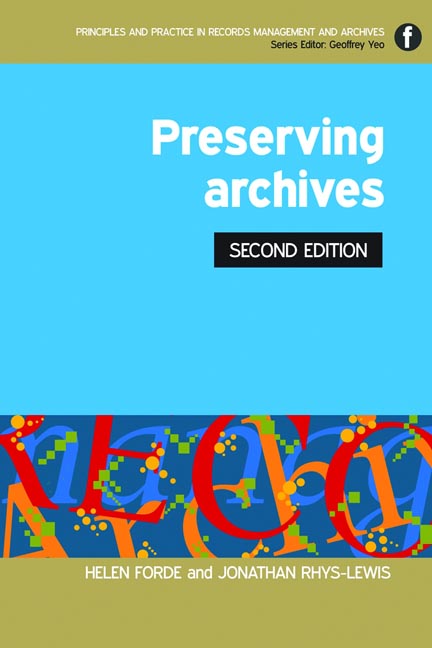Book contents
- Frontmatter
- Contents
- Introduction to the series Geoffrey Yeo
- Preface to the Second Edition
- Acknowledgements
- 1 Introducing archive preservation
- 2 Understanding archival materials and their characteristics
- 3 Managing digital preservation
- 4 Archive buildings and their characteristics
- 5 Safeguarding the building and its contents
- 6 Managing archival storage
- 7 Managing risks and avoiding disaster
- 8 Creating and using surrogates
- 9 Moving the records
- 10 Exhibiting archives
- 11 Handling the records
- 12 Managing a pest control programme
- 13 Training and the use of volunteers
- 14 Putting preservation into practice
- Appendices
- Bibliography
- British and international standards relating to archive preservation
- Index
4 - Archive buildings and their characteristics
Published online by Cambridge University Press: 09 June 2018
- Frontmatter
- Contents
- Introduction to the series Geoffrey Yeo
- Preface to the Second Edition
- Acknowledgements
- 1 Introducing archive preservation
- 2 Understanding archival materials and their characteristics
- 3 Managing digital preservation
- 4 Archive buildings and their characteristics
- 5 Safeguarding the building and its contents
- 6 Managing archival storage
- 7 Managing risks and avoiding disaster
- 8 Creating and using surrogates
- 9 Moving the records
- 10 Exhibiting archives
- 11 Handling the records
- 12 Managing a pest control programme
- 13 Training and the use of volunteers
- 14 Putting preservation into practice
- Appendices
- Bibliography
- British and international standards relating to archive preservation
- Index
Summary
Introduction
Archive buildings are the first stage of protection for the materials kept within them and, as such, are crucial in ensuring survival. Archive buildings, of greater and lesser complexity, have been developed from this basic premise all over the world, adapted to differing climates and the needs of the archives themselves. The importance of understanding the need to build them in the right place, of constructing them in an appropriate way, and of employing experienced practitioners to minimize the threats posed to fragile materials, cannot be overestimated. Likewise, the issues surrounding the adaptation of buildings for use as archives must be appreciated and considered.
This chapter looks at:
• the ways in which archive buildings have developed internationally and in the UK in particular
• issues to consider before constructing an archive or adapting an old building
• how to get ideas over to an architect
• exterior and interior layouts and specifications.
How has the concept of archive buildings developed?
Continuity of custody in secure ownership constitutes the fundamental guarantee of archival authenticity. Hence, security has always been at the forefront of all decisions on the storage of archival material. This is obvious from the choice of storage places over time – for example, the Qumran caves in which the Dead Sea Scrolls (from 200 BC) were hidden, the massive bronze chests in the Forbidden Palace in Beijing in which documents of the Chinese dynasties were stored from the 15th century, and the construction of the Lyndon B. Johnson Museum and Library to house presidential papers of the 20th century. The concept that a building must also be attractive to users and staff is of more recent origin, and has been achievable partly as a result of applying modern technology, including electronic security. This change also mirrors the recognition that public archives are the documents of the people, who have a right to access information and to consult both historic and contemporary documents.
How did archive buildings develop in the UK?
Keeping the documents of the Crown, and subsequently of central government, safe was a major concern in the UK from the time of the Norman Conquest in 1066.
- Type
- Chapter
- Information
- Preserving Archives , pp. 41 - 58Publisher: FacetPrint publication year: 2013



